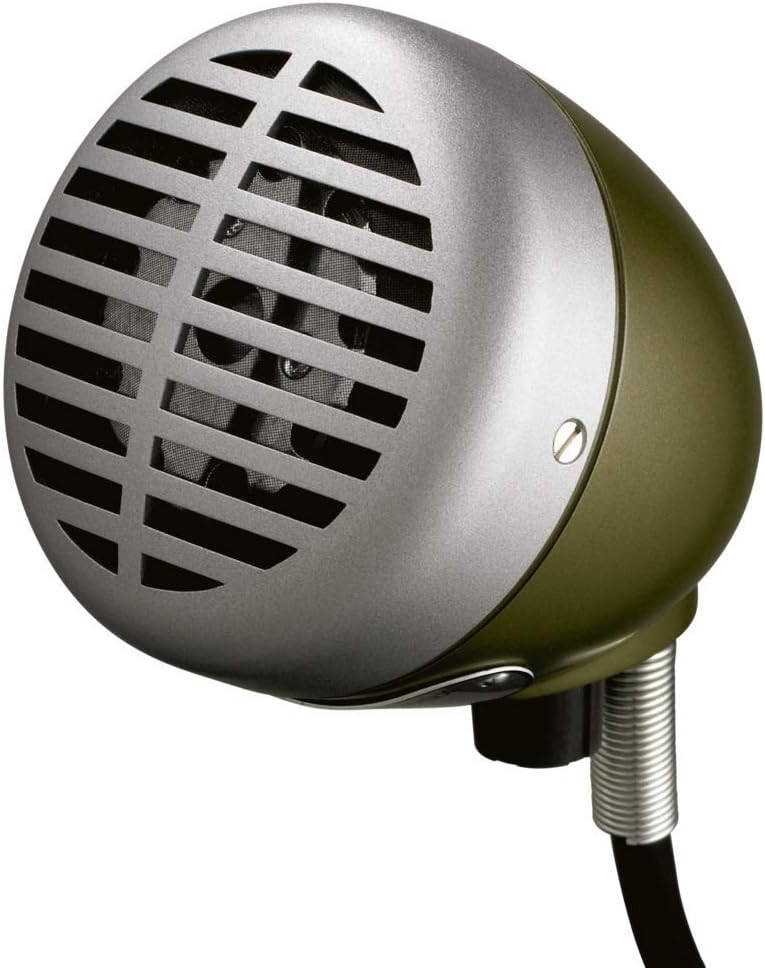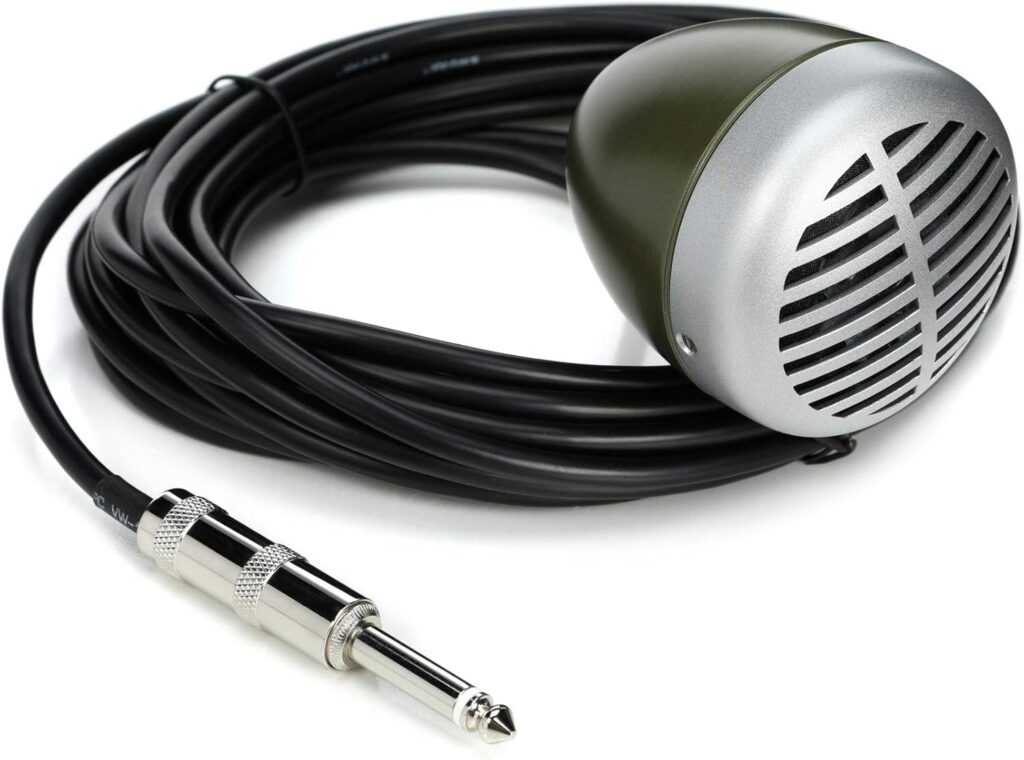Shure 520DX Review
The Shure 520DX, affectionately known as the “Green Bullet,” is more than just a microphone—it’s a cultural artifact, a sonic signature, and a staple in the world of blues harmonica. Since its introduction, this dynamic microphone has carved out a legendary status among musicians, particularly harmonica players seeking that gritty, warm tone synonymous with Chicago blues. In this review, we’ll dive into its history, design, sound quality, performance, practical applications, and overall value, drawing from user experiences, expert insights, and technical specifications. Whether you’re a harmonica player, a producer, or a curious audiophile, this review will help you decide if the Shure 520DX deserves a spot in your gear collection.
Shure 520DX “Green Bullet” Review
To understand the Shure 520DX, we need to step back in time. The Green Bullet lineage began with the Shure 520, introduced in the 1940s as a general-purpose microphone, not originally intended for harmonica players. Its early iterations were designed for public address systems and two-way radio communications, featuring a controlled reluctance transducer—a technology Shure pioneered for rugged, reliable performance. The distinctive bullet shape and green powder-coated finish gave it a unique aesthetic that stood out from the sleek condenser mics of the era.
Harmonica players, particularly in the burgeoning Chicago blues scene of the 1950s, discovered that the 520’s high-impedance design and midrange-focused frequency response paired perfectly with their instruments when plugged into guitar amplifiers. Icons like Little Walter and Junior Wells cemented its reputation by cupping the mic with their harmonicas, creating a distorted, soulful tone that became the backbone of electric blues. The 520DX, introduced later as an evolution of the original, added a volume control knob and refined the cartridge, making it a more versatile tool while retaining its vintage charm.
Today, on March 21, 2025, the Shure 520DX remains a go-to choice for harmonica players and experimental musicians alike, proving that some designs are timeless.
Design and Build Quality
The Shure 520DX is instantly recognizable. Its die-cast zinc body, finished in a signature green and chrome color scheme, evokes a retro vibe that’s both functional and stylish. Measuring approximately 63mm in height and 82.6mm in diameter, it’s contoured to fit snugly between a harmonica and the player’s hands—a critical feature for the “cupping” technique that defines its sound. Weighing in at about 737 grams (including the cable), it’s heftier than many modern mics, but this weight contributes to its durability and solid feel.
The microphone features a 6.1-meter (20-foot) two-conductor shielded cable with a standard 1/4-inch TS (tip-sleeve) phone plug, designed for high-impedance inputs like guitar amps. Unlike XLR-based mics, this fixed cable eliminates the need for adapters in live settings, though it can be a limitation for studio use with low-impedance systems (more on that later). A standout feature is the volume control knob at the base, allowing players to adjust levels on the fly—a practical addition for live performance.
Shure’s reputation for rugged construction shines through here. The 520DX is built to withstand the rigors of the road—drops, sweat, and the occasional beer spill won’t faze it. Users consistently praise its tank-like durability, with some reporting decades of reliable use. However, the fixed cable has drawn criticism; if it frays or fails, repair requires technical know-how or a trip to a service center.
Technical Specs
Let’s break down the 520DX’s specs:
- Type: Dynamic (controlled reluctance cartridge)
- Polar Pattern: Omnidirectional
- Frequency Response: 100 Hz to 5,000 Hz
- Sensitivity: -38.0 dBV/Pa (13 mV)
- Impedance: High (exact value not specified, but optimized for high-Z inputs)
- Connector: 1/4-inch TS plug via attached 20ft cable
- Maximum SPL: 94 dB
The frequency response is narrow compared to modern vocal mics, which often span 20 Hz to 20 kHz. This limited range—focused on the midrange—is intentional, enhancing the harmonica’s natural growl while rejecting unwanted lows and highs. The omnidirectional pickup pattern means it captures sound equally from all directions, making it less prone to proximity effect but more susceptible to feedback in loud environments.
Sound Quality: The Heart of the Green Bullet
The Shure 520DX’s sound is its defining trait. Plug it into a tube amp, cup it with a harmonica, and you’ll hear a warm, gritty tone that’s unmistakably bluesy. The controlled reluctance cartridge delivers a slightly distorted, lo-fi character—think Little Walter’s “My Babe” or Howlin’ Wolf’s raw energy. The midrange emphasis (peaking around 500 Hz to 4 kHz) cuts through a mix, giving the harmonica presence without overpowering other instruments.
For harmonica players, the 520DX excels at capturing the instrument’s nuances—reed bends, overblows, and vibrato—while adding a layer of natural compression and saturation when overdriven. The volume knob lets you dial in just the right amount of grit, making it adaptable to different playing styles and amp settings. Users describe it as “dark and warm” compared to brighter alternatives like the Hohner Harp Blaster, ideal for that classic Chicago sound.
Beyond harmonica, the 520DX has niche applications. Some vocalists use it for a lo-fi, vintage effect, akin to a megaphone or old radio broadcast. Drummers have experimented with it on snares for a twangy, unconventional tone, though it’s not a standard choice. Guitarists occasionally mic their amps with it for a raw, unpolished vibe. However, its limited frequency response (cutting off at 5 kHz) makes it unsuitable for clear vocal recording or capturing the full spectrum of most instruments.
Performance in Practice
Live Use
On stage, the 520DX shines. Its high-impedance design pairs seamlessly with guitar amps like a Fender Bassman or Pignose HOG-20, delivering that signature blues tone without additional processing. The volume knob is a game-changer, letting players tweak output mid-performance—crucial when switching between soft bends and wailing solos. The omnidirectional pattern requires careful positioning to avoid feedback, especially with high-gain amps, but experienced players manage this with technique (e.g., cupping tightly or adjusting amp placement).
The fixed cable is a double-edged sword: it’s convenient for plug-and-play gigs but cumbersome to coil and store, and some users report occasional connection issues at the jack. Mounting it on a stand requires an adapter (like the AmmoClip holder), as it’s designed for handheld use.
Studio Use
In the studio, the 520DX is more specialized. Its high-impedance output isn’t ideal for modern low-Z preamps or mixing boards without a matching transformer or DI box. When paired with the right setup, it records harmonica with authenticity and character, though the lo-fi quality may not suit pristine productions. For creative experimentation—think distorted vocals or quirky drum miking—it’s a fun tool, but it won’t replace a versatile condenser or dynamic mic.
Pros and Cons
Pros
- Iconic Sound: Delivers the classic blues harmonica tone with warmth and grit.
- Durable Build: Nearly indestructible, built for years of use.
- Volume Control: Onboard knob enhances live flexibility.
- Ergonomic Design: Fits perfectly with a harmonica for cupping.
- Value: Affordable for its quality and legacy (typically $130-$150).
Cons
- Limited Frequency Range: Not versatile for clear vocals or full-spectrum recording.
- Fixed Cable: Inconvenient for storage and repair.
- High Impedance: Requires specific setups for optimal use.
- Weight: Some find it heavy for long sessions.
- Feedback Risk: Omnidirectional pattern can be tricky in loud settings.
Comparisons to Alternatives
- Hohner Harp Blaster: Brighter and more modern-sounding, with a tighter cardioid pattern, but lacks the 520DX’s vintage charm.
- Shure SM57: A versatile dynamic mic, better for vocals and instruments, but lacks the Green Bullet’s harmonica-specific design and lo-fi tone.
- Astatic JT-30: Another classic harp mic, similar in vibe but less durable and without volume control.
The 520DX stands out for its balance of tradition, ergonomics, and affordability, though it’s less flexible than multi-purpose mics.
Who Should Buy the Shure 520DX?
The 520DX is a must-have for:
- Harmonica Players: Especially those chasing the electric blues sound.
- Blues Musicians: It’s a shortcut to authentic tone.
- Experimental Producers: For lo-fi vocals or unique textures.
It’s less ideal for:
- Studio Purists: Seeking clean, high-fidelity recordings.
- Versatile Performers: Needing one mic for multiple roles.
Conclusion
The Shure 520DX “Green Bullet” isn’t just a microphone—it’s a piece of musical history. Its rugged build, distinctive sound, and practical design make it a standout choice for harmonica players and anyone craving that raw, vintage edge. While its limitations (narrow frequency range, fixed cable) confine it to a niche, it excels within that space like few others. At its price point, it’s a steal for the quality and legacy you’re buying into.
In 2025, as we look at the evolving landscape of audio gear, the 520DX remains a testament to the idea that some tools don’t need reinventing—they just need to keep doing what they do best. If you’re ready to wail the blues or add a quirky twist to your sound, the Green Bullet is calling.


